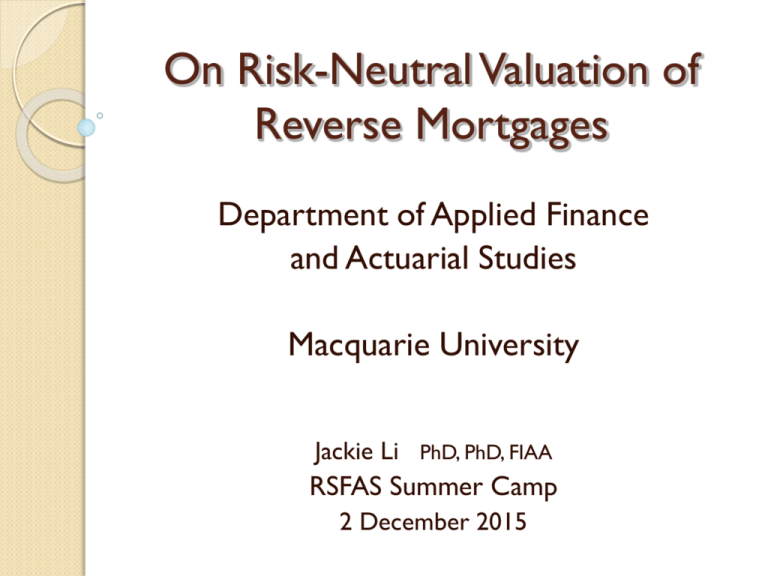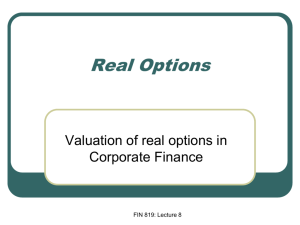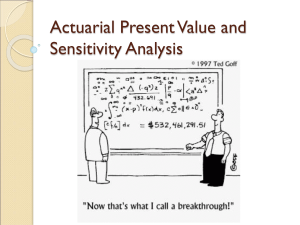On risk-neutral valuation of reverse mortgages
advertisement

On Risk-Neutral Valuation of Reverse Mortgages Department of Applied Finance and Actuarial Studies Macquarie University Jackie Li PhD, PhD, FIAA RSFAS Summer Camp 2 December 2015 Reverse Mortgages life expectancy and dependency ratio continue to rise many retirees are ‘asset-rich-cash-poor’ reverse mortgages can unlock home equity and provide supplementary retirement funding market is growing in Australia and AsiaPacific 2 Reverse Mortgages it allows homeowner to borrow against home property value loan is repaid with interest from sales proceeds of home property when borrower dies it is often non-recourse, i.e. lender cannot have a claim on borrower’s other assets borrower can stay in the same home types / features are many and varied 3 Industry Bodies Senior Australians Equity Release (SEQUAL) Safe Home Income Plans (SHIP) in UK Home Equity Conversion Mortgage (HECM) in US 4 Underlying Risks longevity risk house price risk interest rate risk mis-selling fraud legal risk operational risk 5 Current Regulations Solvency II : make use of and be consistent with information provided by financial markets and generally available data on underwriting risks Prudential Standard APS 111 : maximise use of relevant observable inputs and minimise use of unobservable inputs; only mark-to-model when mark-to-market is not possible 6 Two Valuation Approaches 7 Risk-Neutral Valuation market is complete if there are many securities being traded any cash flow can be replicated by dynamic hedging strategies no-arbitrage principle indicates that there is only one risk-neutral measure and there is only one price expected return is equal to risk-free rate 8 Current Life Market there has been significant development in securitisation of insurance liabilities in recent years e.g. LLMA, catastrophe bond, mortality bond, survivor bond, q-forward, survivor swap but current market is far from having sufficient liquidity market is incomplete 9 Risk-Neutral Valuation if market is incomplete, there are infinitely many risk-neutral measures it is necessary to choose one that is relatively suitable to particular problem e.g. Esscher transform (Gerber and Shiu x X f x e f x e 1994) e.g. Wang transform (Wang 2000) 1 F x F x 10 Risk-Neutral Measures these two transforms have decent properties subjective decisions are usually needed when number of parameters is different to number of security prices available it is not straightforward to allow for multiple risks 11 Current Literature Authors Mortality House Price Interest Rate Wang et al. 2008 GLM + Wang GBM + no-arbitrage Vasicek Hosty et al. 2008 fixed P-spline lognormal fixed Chen et al. 2010 LC with jumps ARIMA-GARCH + conditional Esscher fixed Li et al. 2010 LC ARMA-EGARCH + conditional Esscher fixed Ji et al. 2012 fixed GBM + no-arbitrage fixed Lee et al. 2012 LC + Wang jump diffusion + conditional Esscher risk-neutral CIR Kogure et al. 2014 LC + entropy ARIMA-GARCH + entropy fixed 12 Maximum Entropy Principle minimise Kullback-Leibler information f x criterion f x ln f x dx subject to m constraints of m securities f x dx vi (hi = discounted hi xpayoff vi = market price) subject to constraint f x dx 1 f x f x exp 0 i 1 i hi x m 13 Maximum Entropy Principle discrete version straightforward and flexible to apply in practice find πj* that minimise Kullback-Leibler information criterion Σπj*ln(πj*/πj) for j = 1 , 2 , … , n paths subject to m constraints of m securities Σhi,jπj* = vi subject to constraint Σπj* = 1 Lagrange multiplier 14 Maximum Entropy Principle any number of security prices can be incorporated different simulation methods can be used it can be applied to different risks consistently and coherently there are some theoretical and empirical support 15 Maximum Entropy Principle Frittelli (2000) proves equivalence between maximisation of expected exponential utility and minimisation of Kullback-Leibler information criterion Stutzer (1996) reports that it produces prices close to Black-Scholes prices Gray and Newman (2005) show that it outperforms historic-volatility-based BlackScholes estimator it has been applied to other futures options 16 Longevity Risk Lee and Carter (1992) model ln(mx,t) = ax + bx kt mx,t = central death rate ax = mortality schedule bx = age-specific sensitivity kt = mortality index simple model structure highly linear kt empirically fit ARIMA(0,1,0) to kt for projection 17 Financial Risks house price risk and interest rate risk vector autoregressive (VAR) model e.g. VAR(1) model r tH = c1 + A1,1 r t-1H + A1,2 r t-1I + e1,t r tI = c2 + A2,1 r t-1H + A2,2 r t-1I + e2,t simple model structure for autoregressive effects assume real-world independence between longevity risk and financial risks 18 Reverse Mortgage Example suppose an individual borrows L0 and returns min(Lt , Ht) on death EPV = ΣEQ[d(t) min(Lt , Ht) It] Lt = L0 eut u = fixed loan interest rate Ht = house price It = proportion who dies within (t-1 , t) d(t) = discount factor EPV must be larger than L0 to make it financially viable 19 Two Valuation Approaches 20 Historical Data for fitting LC and VAR models Australian female mortality (ages 65 to 99; period 1968 to 2011) from Human Mortality Database (HMD) residential property price index (2003 to 2014) from Australian Bureau of Statistics (ABS) 90-Day BABs/NCDs yields (2003 to 2014) from Reserve Bank of Australia (RBA) mortality data and house price data are proxies 21 Market Prices Data for setting constraints Australian female mortality (ages 65 to 99) from Australian Life Tables 2005-07 by Australian Government Actuary residential property price index (December 2014) from ABS zero-coupon interest rates (31 December 2014) from RBA mortality data and house price data are proxies 22 Preliminary Results 1 0.8 0.6 F*(x) F(x) 0.4 0.2 0 0.88 0.89 0.9 0.91 0.92 0.93 0.94 0.95 10p65 23 Preliminary Results 1 0.8 0.6 F*(x) F(x) 0.4 0.2 0 130 150 170 190 210 230 250 270 290 310 330 H10 24 Preliminary Results 1 0.8 0.6 F*(x) F(x) 0.4 0.2 0 0 0.01 0.02 0.03 0.04 0.05 0.06 0.07 0.08 0.09 0.1 r10 25 References Australian Prudential Regulation Authority (APRA), 2013, Prudential Standard APS 111 Chen H., Cox S.H., and Wang S.S., 2010, Is the home equity conversion mortgage in the United States sustainable? Evidence from pricing mortgage insurance premiums and non-recourse provisions using the conditional Esscher transform, Insurance: Mathematics and Economics 46: 371-384 Frittelli M., 2000, The minimal entropy martingale measure and the valuation problem in incomplete market, Mathematical Finance 10: 39-52 Gerber H.U. and Shiu E.S.W., 1994, Option pricing by Esscher transforms, Transactions of the Society of Actuaries 46: 99-191 Gray P. and Newman S., 2005, Canonical valuation of options in the presence of stochastic volatility, Journal of Futures Markets 25: 1-19 26 References Hosty G.M., Groves S.J., Murray C.A., and Shah M., 2008, Pricing and risk capital in the equity release market, British Actuarial Journal 14(1): 41-109 Ji M., Hardy M., and Li J.S.H., 2012, A semi-Markov multiple state model for reverse mortgage terminations, Annals of Actuarial Science 6(2): 235-257 Kogure A., Li J., and Kamiya S., 2014, A Bayesian multivariate risk-neutral method for pricing reverse mortgages, North American Actuarial Journal 18(1): 242-257 Lee R. and Carter L., 1992, Modeling and forecasting US mortality, Journal of the American Statistical Association 87: 659-671 Lee Y.T., Wang C.W., and Huang H.C., 2012, On the valuation of reverse mortgages with regular tenure payments, Insurance: Mathematics and Economics 51: 430-441 27 References Li J.S.H., Hardy M.R., and Tan K.S., 2010, On pricing and hedging the nonegative-equity guarantee in equity release mechanisms, Journal of Risk and Insurance 77(2): 499-522 Solvency II Directive 2009/138/EC, Official Journal of the European Union Stutzer M., 1996, A simple nonparametric approach to derivative security valuation, Journal of Finance 51: 1633-1652 Wang L., Valdez E.A., and Piggott J., 2008, Securitization of longevity risk in reverse mortgages, North American Actuarial Journal 12(4): 345-371 Wang S., 2000, A class of distortion operators for pricing financial and insurance risks, Journal of Risk and Insurance 67: 15-36 28








